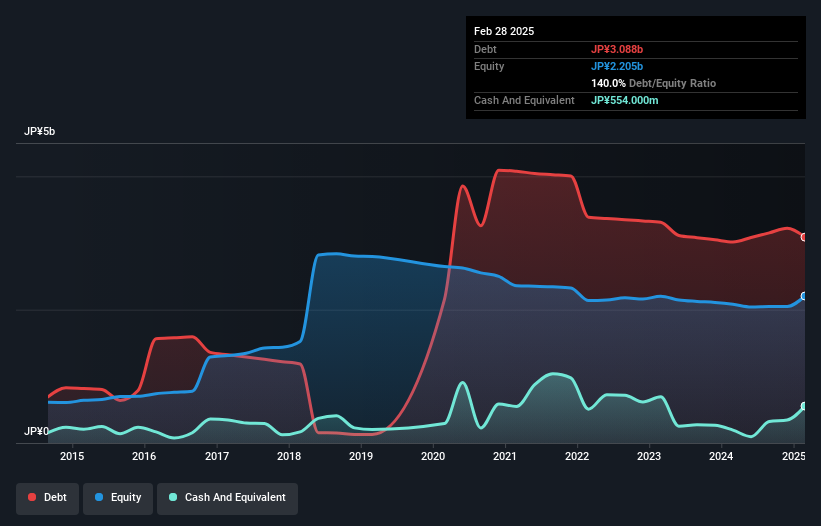Some say volatility, rather than debt, is the best way to think about risk as an investor, but Warren Buffett famously said that 'Volatility is far from synonymous with risk.' So it seems the smart money knows that debt - which is usually involved in bankruptcies - is a very important factor, when you assess how risky a company is. We note that Shirohato Co., Ltd. (TSE:3192) does have debt on its balance sheet. But the more important question is: how much risk is that debt creating?
We've discovered 3 warning signs about Shirohato. View them for free.When Is Debt A Problem?
Generally speaking, debt only becomes a real problem when a company can't easily pay it off, either by raising capital or with its own cash flow. If things get really bad, the lenders can take control of the business. However, a more common (but still painful) scenario is that it has to raise new equity capital at a low price, thus permanently diluting shareholders. By replacing dilution, though, debt can be an extremely good tool for businesses that need capital to invest in growth at high rates of return. When we think about a company's use of debt, we first look at cash and debt together.
What Is Shirohato's Debt?
The chart below, which you can click on for greater detail, shows that Shirohato had JP¥3.09b in debt in February 2025; about the same as the year before. However, it does have JP¥554.0m in cash offsetting this, leading to net debt of about JP¥2.53b.

How Strong Is Shirohato's Balance Sheet?
We can see from the most recent balance sheet that Shirohato had liabilities of JP¥1.93b falling due within a year, and liabilities of JP¥1.82b due beyond that. Offsetting these obligations, it had cash of JP¥554.0m as well as receivables valued at JP¥323.0m due within 12 months. So its liabilities total JP¥2.88b more than the combination of its cash and short-term receivables.
When you consider that this deficiency exceeds the company's JP¥2.00b market capitalization, you might well be inclined to review the balance sheet intently. In the scenario where the company had to clean up its balance sheet quickly, it seems likely shareholders would suffer extensive dilution.
Check out our latest analysis for Shirohato
In order to size up a company's debt relative to its earnings, we calculate its net debt divided by its earnings before interest, tax, depreciation, and amortization (EBITDA) and its earnings before interest and tax (EBIT) divided by its interest expense (its interest cover). Thus we consider debt relative to earnings both with and without depreciation and amortization expenses.
Shirohato shareholders face the double whammy of a high net debt to EBITDA ratio (11.2), and fairly weak interest coverage, since EBIT is just 1.2 times the interest expense. The debt burden here is substantial. One redeeming factor for Shirohato is that it turned last year's EBIT loss into a gain of JP¥36m, over the last twelve months. When analysing debt levels, the balance sheet is the obvious place to start. But it is Shirohato's earnings that will influence how the balance sheet holds up in the future. So if you're keen to discover more about its earnings, it might be worth checking out this graph of its long term earnings trend.
Finally, while the tax-man may adore accounting profits, lenders only accept cold hard cash. So it is important to check how much of its earnings before interest and tax (EBIT) converts to actual free cash flow. Happily for any shareholders, Shirohato actually produced more free cash flow than EBIT over the last year. There's nothing better than incoming cash when it comes to staying in your lenders' good graces.
Our View
On the face of it, Shirohato's net debt to EBITDA left us tentative about the stock, and its interest cover was no more enticing than the one empty restaurant on the busiest night of the year. But at least it's pretty decent at converting EBIT to free cash flow; that's encouraging. Looking at the bigger picture, it seems clear to us that Shirohato's use of debt is creating risks for the company. If all goes well, that should boost returns, but on the flip side, the risk of permanent capital loss is elevated by the debt. There's no doubt that we learn most about debt from the balance sheet. However, not all investment risk resides within the balance sheet - far from it. To that end, you should learn about the 3 warning signs we've spotted with Shirohato (including 1 which can't be ignored) .
Of course, if you're the type of investor who prefers buying stocks without the burden of debt, then don't hesitate to discover our exclusive list of net cash growth stocks, today.
New: Manage All Your Stock Portfolios in One Place
We've created the ultimate portfolio companion for stock investors, and it's free.
• Connect an unlimited number of Portfolios and see your total in one currency
• Be alerted to new Warning Signs or Risks via email or mobile
• Track the Fair Value of your stocks
Have feedback on this article? Concerned about the content? Get in touch with us directly. Alternatively, email editorial-team (at) simplywallst.com.
This article by Simply Wall St is general in nature. We provide commentary based on historical data and analyst forecasts only using an unbiased methodology and our articles are not intended to be financial advice. It does not constitute a recommendation to buy or sell any stock, and does not take account of your objectives, or your financial situation. We aim to bring you long-term focused analysis driven by fundamental data. Note that our analysis may not factor in the latest price-sensitive company announcements or qualitative material. Simply Wall St has no position in any stocks mentioned.
About TSE:3192
Good value with acceptable track record.
Market Insights
Community Narratives



